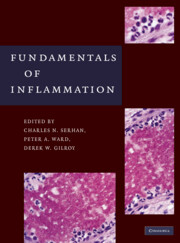Book contents
- Frontmatter
- Contents
- Contributors
- Preface
- PART I THE INFLAMMATORY RESPONSE – AN OVERVIEW
- PART II INDIVIDUAL CELL TYPES
- PART III CHEMICAL MEDIATORS
- 12 Lipid Mediators in Acute Inflammation and Resolution: Eicosanoids, PAF, Resolvins, and Protectins
- 13 Cytokines and Chemokines in Inflammation
- 14 Adenosine Receptors: Therapeutic Aspects for Inflammatory and Immune Diseases
- 15 Leukocyte Generation of Reactive Oxygen Species
- 16 Cell Adhesion Molecules
- PART IV IMMUNOPHARMACOLOGY
- PART V INFLAMMATORY DISEASES/HISTOLOGY
- PART VI ANIMAL MODELS OF INFLAMMATION
- Index
- References
14 - Adenosine Receptors: Therapeutic Aspects for Inflammatory and Immune Diseases
from PART III - CHEMICAL MEDIATORS
Published online by Cambridge University Press: 05 April 2014
- Frontmatter
- Contents
- Contributors
- Preface
- PART I THE INFLAMMATORY RESPONSE – AN OVERVIEW
- PART II INDIVIDUAL CELL TYPES
- PART III CHEMICAL MEDIATORS
- 12 Lipid Mediators in Acute Inflammation and Resolution: Eicosanoids, PAF, Resolvins, and Protectins
- 13 Cytokines and Chemokines in Inflammation
- 14 Adenosine Receptors: Therapeutic Aspects for Inflammatory and Immune Diseases
- 15 Leukocyte Generation of Reactive Oxygen Species
- 16 Cell Adhesion Molecules
- PART IV IMMUNOPHARMACOLOGY
- PART V INFLAMMATORY DISEASES/HISTOLOGY
- PART VI ANIMAL MODELS OF INFLAMMATION
- Index
- References
Summary
Metabolic stress, hypoxia, and cell damage cause adenosine to accumulate in the extracellular space, and increases in extracellular adenosine levels are observed in hypoxia, ischemia, inflammation, and trauma [1, 2]. Extracellular adenosine levels accumulate following the release of adenosine from cells or as a consequence of extracellular degradation of released ATP and ADP. Intracellular adenosine, which can originate from increased intracellular metabolism of ATP during cellular stress or S-adenosyl homocysteine, is released through equilibrative nucleoside transporters ENT1 and ENT2. Extracellular ATP and ADP are catabolized by a cascade of ectoenzymes which consists of CD39 (ENTPD1 [ectonucleoside triphosphate diphosphohydrolase-1]), an enzyme that hydrolyzes ATP and ADP to AMP, and CD73 (ecto-5'nucleotidase), which in turn, rapidly dephosphorylates AMP to adenosine [3]. Owing to the widespread expression of equilibrative nucleoside transporters, adenosine derived from extracellular ATP is rapidly recycled from the extracellular space by uptake into cells. Adenosine in the cytosol is then either phosphorylated by adenosine kinase to AMP or metabolized by adenosine deaminase to inosine [4, 5]. As a net result of these various metabolic processes, adenosine levels in the extracellular space are maintained in a range of 10–200 nM in normal, healthy tissues. In contrast, under pathophysiological conditions adenosine is generated at a rate that is higher than the rate of degradation leading to markedly increased extracellular adenosine levels that can range between 10 and 100 μM.
- Type
- Chapter
- Information
- Fundamentals of Inflammation , pp. 186 - 197Publisher: Cambridge University PressPrint publication year: 2010



